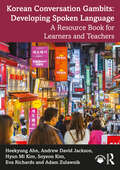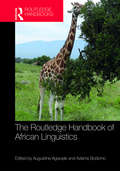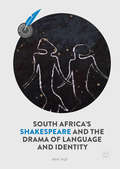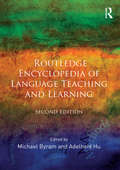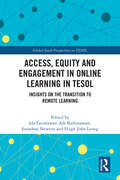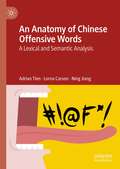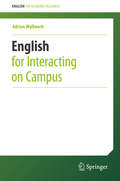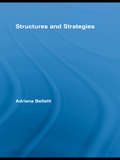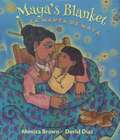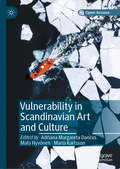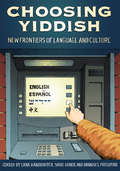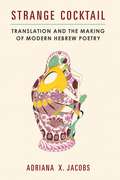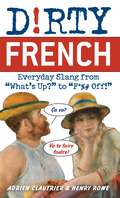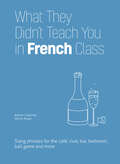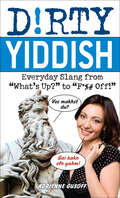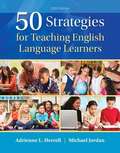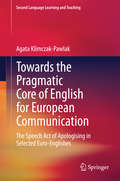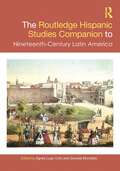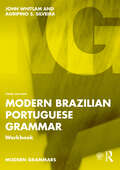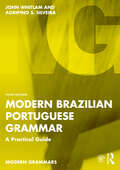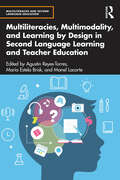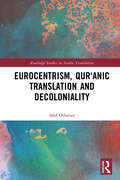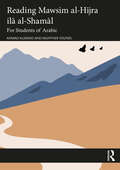- Table View
- List View
Korean Conversation Gambits: A Resource Book for Learners and Teachers
by Soyeon Kim Adam Zulawnik Andrew David Jackson Heekyung Ahn Hyun Mi Kim Eva RichardsKorean Conversation Gambits: Developing Spoken Language provides specific linguistic and communicative strategies that help Korean language learners engage in daily conversations as well as discussions and negotiations in work and academic contexts. The book presents, and provides practice in, spoken Korean gambits that will help speakers organise their conversations and frame the type of extended discourse that is common in spoken Korean. The book introduces students to strategies for getting thinking time, dealing with breakdowns in comprehension, asking for and providing clarification, exemplifying, floor-holding, interrupting, checking understanding, disagreeing, reformulating and organising longer stretches of discourse; for example, when giving presentations, telling stories or providing self-introductions. Korean Conversation Gambits: Developing Spoken Language comes complete with classroom-ready practice materials.This textbook can be used as a resource by both teachers and Korean learners from introductory to intermediate and proficient levels.
An Anthology of Informal Latin, 200 BC – AD 900
by Adams J. n.This book contains over fifty passages of Latin from 200 BC to AD 900, each with translation and linguistic commentary. It is not intended as an elementary reader (though suitable for university courses), but as an illustrative history of Latin covering more than a millennium, with almost every century represented. Conventional histories cite constructions out of context, whereas this work gives a sense of the period, genre, stylistic aims and idiosyncrasies of specific passages. 'Informal' texts, particularly if they portray talk, reflect linguistic variety and change better than texts adhering to classicising norms. Some of the texts are recent discoveries or little known. Writing tablets are well represented, as are literary and technical texts down to the early medieval period, when striking changes appear. The commentaries identify innovations, discontinuities and phenomena of long duration. Readers will learn much about the diversity and development of Latin.
The Routledge Handbook of African Linguistics (Routledge Language Handbooks)
by Augustine Agwuele Adams BodomoThe Handbook of African Linguistics provides a holistic coverage of the key themes, subfields, approaches and practical application to the vast areas subsumable under African linguistics that will serve researchers working across the wide continuum in the field. Established and emerging scholars of African languages who are active and current in their fields are brought together, each making use of data from a linguistic group in Africa to explicate a chosen theme within their area of expertise, and illustrate the practice of the discipline in the continent.
South Africa's Shakespeare and the Drama of Language and Identity (Global Shakespeares)
by Adele SeeffThis volume considers the linguistic complexities associated with Shakespeare’s presence in South Africa from 1801 to early twentieth-first century televisual updatings of the texts as a means of exploring individual and collective forms of identity. A case study approach demonstrates how Shakespeare’s texts are available for ideologically driven linguistic programs. Seeff introduces the African Theatre, Cape Town, in 1801, multilingual site of the first recorded performance of a Shakespeare play in Southern Africa where rival, amateur theatrical groups performed in turn, in English, Dutch, German, and French. Chapter 3 offers three vectors of a broadening Shakespeare diaspora in English, Afrikaans, and Setswana in the second half of the nineteenth century. Chapter 4 analyses André Brink’s Kinkels innie Kabel, a transposition of Shakespeare’s The Comedy of Errors into Kaaps, as a radical critique of apartheid’s obsession with linguistic and ethnic purity. Chapter 5 investigates John Kani’s performance of Othello as a Xhosa warrior chief with access to the ancient tradition of Xhosa storytellers. Shakespeare in Mzansi, a televisual miniseries uses black actors, vernacular languages, and local settings to Africanize Macbeth and reclaim a cross-cultural, multilingualism. An Afterword assesses the future of Shakespeare in a post-rainbow, decolonizing South Africa. Global Sha Any reader interested in Shakespeare Studies, global Shakespeare, Shakespeare in performance, Shakespeare and appropriation, Shakespeare and language, Literacy Studies, race, and South African cultural history will be drawn to this book.
Routledge Encyclopedia of Language Teaching and Learning
by Michael Byram Adelheid HuThe Routledge Encyclopedia of Language Teaching and Learning is an authoritative reference dealing with all aspects of this increasingly important field of study. Offering a comprehensive range of articles on contemporary language teaching and its history, it has been produced specifically for language teaching professionals and as a reference work for academic studies at postgraduate level. In this new edition, every single entry has been reviewed and updated with reference to new developments and publications. Coverage has been expanded to reflect new technological, global and academic developments, with particular attention to areas such as online and distance learning, teacher and learner cognition, testing, assessment and evaluation, global English and teacher education. Themes and disciplines covered include: Methods and materials, including new technologies and materials development Contexts and concepts, such as mediation, risk-taking in language learning and intercomprehension Influential figures from the early days of language teaching to the contemporary Related disciplines, such as psychology, anthropology and corpus linguistics It covers the teaching of specific languages, including Japanese, Chinese, Arabic and African languages, as well as English, French, German and Spanish. There are thirty five overview articles dealing with issues such as communicative language teaching, early language learning, teacher education and syllabus and curriculum design. A further 160 entries focus on topics such as bilingualism, language laboratories and study abroad. Numerous shorter items examine language and cultural institutions, professional associations and acronyms. Multiple cross-references enable the user to browse from one entry to another, and there are suggestions for further reading. Written by an international team of specialists, the Routledge Encyclopedia of Language Teaching and Learning is an invaluable resource and reference manual for anyone with a professional or academic interest in the subject.
Access, Equity and Engagement in Online Learning in TESOL: Insights on the Transition to Remote Learning (Global South Perspectives on TESOL)
by Jonathan Newton Adi Badiozaman, Ida Fatimawati Hugh John LeongThis volume explores difficulties facing TESOL education’s transition to online learning in the Global South and Southeast Asia/Asia Pacific region, highlighting innovations of educators in engaging learners, thereby exploring the key themes of access, engagement, and equity in the field.Discussing themes such as academic burnout, cultural competence, and emotional regulation strategies in challenging educational contexts, this novel volume gives voice to field experiences encountered in countries such as Malaysia, Indonesia, Oman, Vietnam, China, and Iran. Chapters demonstrate how a lack of access to reliable internet connectivity and a shortage of digital devices, especially in rural areas, compound limited opportunities for students already facing educational inequalities, presenting the innovative and creative ways English educators are responding to these situations. Across interviews and qualitative studies, the book demonstrates that issues surrounding engagement with, access to, and equity within, the remote and online educational context are wider and longer lasting than the recent pandemic period itself and are at the forefront of challenges facing these regions today.Highlighting English educators’ resilience, perseverance, and creativity in challenging circumstances, the book will be of interest to researchers, scholars, and postgraduate students in open and distance education, eLearning, bilingualism/ESL, and distribution of technology in educational settings.
Language Conflict in Educational Settings: International Perspectives (Routledge Research in Language Education)
by Adolfo Elizaincín Yliana V. RodríguezLanguage Conflict in Educational Settings: International Perspectives delves into the intriguing intersection of contact linguistics and education, a topic that has been relatively unexplored until now.With contributions from scholars across the globe, the book ventures into the realms of conflict linguistics in educational scenarios. Language contact, often fraught with internal and external conflicts, impacts education significantly. Drawing on scholarship representative of different locations, backgrounds, and disciplinary angles, the authors present studies of pairs and triads of different language families from across the Americas, Africa, Asia, and Europe, ultimately demonstrating how language contact leads to conflict, and how the latter eventually affects education processes and outcomes. Presenting a diverse set of theoretical perspectives and methodologies, it asks to what extent these impacts are detrimental to educational outcomes, and more specifically, how language conflict can impact education in the form of policy, teaching, and learning. As such, it provides essential insights for educators, policymakers, and professionals in the fields of education, linguistics, and cultural studies, offering valuable case studies in the under-researched field of language conflict. It ultimately contributes to the enhancement of education in language contact contexts and fosters a deeper understanding of this critical intersection.This book is an invaluable resource for researchers, scholars, and teacher-educators, offering insights to help understand such an intricate phenomenon, as well as those working across language education, linguistics, and the sociology of language more broadly.
An Anatomy of Chinese Offensive Words: A Lexical and Semantic Analysis
by Lorna Carson Ning Jiang Adrian TienThis book offers a precise and rigorous analysis of the meanings of offensive words in Chinese. Adopting a semantic and cultural approach, the authors demonstrate how offensive words can and should be systematically researched, documented and accounted for as a valid aspect of any language. The book will be of interest to academics, practitioners and students of sociolinguistics, language and culture, linguistic taboo, Chinese studies and Chinese linguistics.
English for Interacting on Campus
by Adrian WallworkThis volume covers the day-to-day activities of a non-native English speaking student carrying out research, attending lectures, socializing, and living in a foreign country. Whether on a US campus as a foreign student, or in a non-English speaking country where classes are given in English, this book will help students build confidence in interacting with professors and fellow students.
Structures and Strategies (Routledge Leading Linguists)
by Adriana BellettiFollowing crucial insights on the functional structure of the clause and recent developments within the cartographic projects and minimalism, this book addresses various central themes in Italian and Romance syntax ranging from verb syntax and the syntax of verb-related phenomena of agreement and cliticization, to word order issues and their status in discourse contexts. It illustrates a research program where the basic formal components of grammar, the rich cartographic syntactic structures, are directly implicated in morphosyntactic computations proper as well as in the articulation of discourse strategies.
Vulnerability in Scandinavian Art and Culture
by Mats Hyvönen Adriana Margareta Dancus Maria KarlssonIn this open access book, seventeen scholars discuss how contemporary Scandinavian art and media have become important arenas to articulate and stage various forms of vulnerability in the Scandinavian welfare states. How do discourses of privilege and vulnerability coexist and interact in Scandinavia? How do the Scandinavian countries respond to vulnerability given increased migration? How is vulnerability distributed in terms of margin and centre, normality and deviance? And how can vulnerability be used to move audiences towards each other and accomplish change? We address these questions in an interdisciplinary study that brings examples from celebrated and provocative fiction and documentary films, TV-series, reality TV, art installations, design, literature, graphic art, radio podcasts and campaigns on social media.
Choosing Yiddish: New Frontiers of Language and Culture
by Dara Horn Jeffrey Shandler Jeremy Dauber Josh Lambert Barbara Kirshenblatt-Gimblett Kalman Weiser Hasia Diner Ari Y. Kelman Tony Michels Gennady Estraikh Sarah Bunin Benor Anita Norich Rebecca Margolis Zehavit Stern Asya Vaisman Shiri Goren Lara Rabinovitch Gerben Zaagsma Edward Portnoy Jennifer Young Ela Bauer Shachar Pinsker Shayn Smulyan Adriana X. Jacobs Barbara Mann Jordan Finkin Rebecca Kobrin Hannah S. Pressman Anna ShternshisYiddish Hip Hop, a nineteenth-century "Hasidic Slasher," obscure Yiddish writers, and immigrant Jewish newspapers in Buenos Aires, Paris, and New York are just a few of the topics featured in Choosing Yiddish: New Frontiers of Language and Culture. Editors Lara Rabinovitch, Shiri Goren, and Hannah S. Pressman have gathered a diverse and richly layered collection of essays that demonstrates the currency of Yiddish scholarship in academia today.Organized into six thematic rubrics, Choosing Yiddish demonstrates that Yiddish, always a border-crossing language, continues to push boundaries with vigorous disciplinary exchange. "Writing on the Edge" focuses on the realm of belles lettres; "Yiddish and the City" spans the urban centers of Paris, Buenos Aires, New York City, and Montreal; "Yiddish Goes Pop" explores the mediating role of Yiddish between artistic vision and popular culture; "Yiddish Comes to America" focuses on the history and growth of Yiddish in the United States; "Yiddish Encounters Hebrew" showcases interactions between Yiddish and Hebrew in the late nineteenth and twentieth centuries; and "Hear and Now" explores the aural dimension of Yiddish in contemporary settings. Along the way, contributors consider famed and lesser-known Yiddish writers, films, and Yiddish hip-hop, as well as historical studies on the Yiddish press, Yiddish film melodrama, Hasidic folkways, and Yiddish culture in Israel. Venerable scholars introduce each rubric, creating additional dialogue between newer and more established voices in the field.The international contributors prove that the language--far from dying--is fostering exciting new directions of academic and popular discourse, rooted in the field's historic focus on interdisciplinary research. Students and teachers of Yiddish studies will enjoy this innovative collection.
Strange Cocktail: Translation and the Making of Modern Hebrew Poetry (Michigan Studies In Comparative Jewish Cultures)
by Adriana X. JacobsFor centuries, poets have turned to translation for creative inspiration. Through and in translation, poets have introduced new poetic styles, languages, and forms into their own writing, sometimes changing the course of literary history in the process. Strange Cocktail is the first comprehensive study of this phenomenon in modern Hebrew literature of the late nineteenth century to the present day. Its chapters on Esther Raab, Leah Goldberg, Avot Yeshurun, and Harold Schimmel offer close readings that examine the distinct poetics of translation that emerge from reciprocal practices of writing and translating. Working in a minor literary vernacular, the translation strategies that these poets employed allowed them to create and participate in transnational and multilingual poetic networks. Strange Cocktail thereby advances a comparative and multilingual reframing of modern Hebrew literature that considers how canons change and are undone when translation occupies a central position—how lines of influence and affiliation are redrawn and literary historiographies are revised when the work of translation occupies the same status as an original text, when translating and writing go hand in hand.
Dirty French: Everyday Slang from (Dirty Everyday Slang Ser.)
by Henry Rowe Adrien ClautrierGET D!RTYNext time you're traveling or just chattin' in French with your friends, drop the textbook formality and bust out with expressions they never teach you in school, including: Cool slang Funny insults Explicit sex terms Raw swear wordsDirty French teaches the casual expressions heard every day on the streets of France: What's up?Ça va? He's totally hot.Il est un gravure de mode. That brie smells funky.Ce brie sent putain de drôle. I'm gonna get ripped!Je vais me fracasser! I gotta piss.Je dois pisser. The ref is fucking asshole.L'arbitre est un gros enaelé! Wanna try doggy-style?Veux-tu faire l'amour en levrette?
What They Didn't Teach You in French Class: Slang Phrases for the Café, Club, Bar, Bedroom, Ball Game and More (Dirty Everyday Slang)
by Henry Rowe Adrien ClautrierDrop the textbook formality and chat with the locals in France’s everyday language—from common words for meeting and greeting to colorful insults. Sipping a café au lait at a sidewalk bistro . . . Getting down at Paris’s hottest club . . . Cheering on Les Bleus at the stadium . . . Packed with slang words, phrases and expressions not found in any textbook, this fun-to-read handbook teaches the casual, everyday language heard in the cafes, bars, and streets of France. No one actually speaks the formal French taught in school, which makes this book a must-have for anyone looking to chat with the locals without sounding like a robot. This handy phrasebook is perfect for travelers and students who want to fill the gap between the French they are learning in class and what is really spoken in France.What’s up? Ça va?She’s totally hot. Elle est bandante.This party is lit! Cette bringue est enflammée!That brie smells funky. Ce brie sent putain de drôle.Wanna French kiss? On se roule une pelle?That ref is a moron. L’arbitre est un abruti.
Dirty Yiddish: Everyday Slang from "What's Up?" to "F*%# Off!" (Dirty Everyday Slang)
by Adrienne GusoffNext time you’re chattin’ with your khaverim (friends) and mishpukheh (family), bust out some Yiddish expressions that’ll liven up the conversation.Nothing is censored in Dirty Yiddish. It includes phrases for any situation, so readers have enough chutzpah (balls) to tell the local deli that they’ve waited long enough for their knish, and explicit swear words crude enough to shock Bubby and everyone else at the Passover seder. There’s even vulgar sex terminology so graphic it puts the outspoken Lower East Side princesses to shame. Bust out with expressions they never teach you in school, including cool slang, funny insults, explicit sex terms, and raw swear words. Dirty Yiddish teaches the casual expressions heard every day on the streets of New York . . . What’s up? Vos makhst du?Crazy bastard! Meshuggeneh momzer!I’m hammered. Ikh bin fershikkert.Don’t fuck with me! Bareh mikh nit!I have the shits. Ikh hob a shittern mogn.Lick my pussy. Lekh meyn lokh.Was it good for you? Tsufreedn?
50 Strategies for Teaching English Language Learners (Teaching Strategies Series)
by Michael Jordan Adrienne Herrell50 Strategies for Teaching English Language Learners includes a rich assortment of practical strategies aligned to TESOL standards, which have been field-tested in diverse classrooms. Each strategy includes a brief explanation, step-by-step instructions on how to plan and use the strategy, and classroom scenarios demonstrating how the strategy can be adapted for different grade levels and content areas. The authors have included additional strategies in language and literacy development, technology, and assessment to support both pre-service and in-service teachers. The Fifth Edition represents a major change in standards-based education that helps educators meet the additional challenges of the Common Core State Standards in the process of acquiring English. Included are six new strategies, self-evaluation rubrics, adaptation charts, classroom examples demonstrating approaches to CCSS, video links, pop-ups encouraging further reading, and a glossary of terms encountered in the text. The Enhanced Pearson eText features embedded video.
Towards the Pragmatic Core of English for European Communication
by Agata Klimczak-PawlakEnglish in Europe is not one but many, and substantial differences in the way people from different countries communicate using it may cause misunderstandings. This book shows that, through research into the pragmatic behaviour of non-native speakers of English from across Europe, it is possible to uncover the core-the shared strategies. This common pragmatic linguistic behaviour is proposed as the basis for a reference guide for those who wish to successfully communicate in English in Europe. The study reported on in this book is based on the analysis of the speech act of apologizing as realized by 466 respondents from 8 European countries, all proficient users of English involved in teacher-training programmes. The results Provide a basis for practical teaching and in-class research.
The Routledge Hispanic Studies Companion to Nineteenth-Century Latin America (Routledge Companions to Hispanic and Latin American Studies)
by Agnes Lugo-Ortiz Javier Muñoz-Basols Pablo Valdivia Graciela MontaldoThe Routledge Hispanic Studies Companion to Nineteenth-Century Latin America provides a unique, comprehensive, and critical overview of Latin American studies in the nineteenth century, including the major regions and subfields.The essays in this collection offer a complex, yet accessible transdisciplinary overview of the heterogeneous and asynchronous historical, political, and cultural processes that account for the becoming of Latin America in the nineteenth century—from Mexico and the Caribbean Basin to the Southern Cone. The thematic division of the book into six parts allows for a better understanding of the ways in which different themes are interrelated and affords readers the opportunity to draw their own connections among subfields. The volume assembles a robust sample of recent and innovative scholarship on the subject, reformulating from fresh perspectives commonly held views on the issues that characterized the era. Additionally, it provides an overarching analysis of the field and introduces cutting-edge concepts all within one expansive volume, opening the dialogue about topics that share common denominators and modeling how those topics can be approached from a variety of perspectives.The innovative volume will be of interest to students and scholars of Latin American studies and Spanish studies. Readers unfamiliar with the period will acquire a comprehensive view of its complexities, while specialists will discover new interpretations and archives.
Modern Brazilian Portuguese Grammar Workbook (Modern Grammar Workbooks)
by John Whitlam Agripino S. SilveiraModern Brazilian Portuguese Grammar Workbook is an innovative book of exercises and language tasks for all learners of Brazilian Portuguese, ideal for use alongside the Modern Brazilian Portuguese Grammar or as an independent resource. The book is divided into two sections. Part A provides exercises based on essential grammatical structures whilst Part B practises everyday functions, including making social contact, asking questions and expressing needs. This third edition offers a greater variety of exercises, including exercises designed to practice concepts introduced in the "Notes for Spanish Speakers" sections of the Grammar. Exercises from the second edition have also been revised and expanded upon and a comprehensive answer key at the back of the book enables you to check on your progress. The Modern Brazilian Portuguese Grammar Workbook is ideal for all learners who have a basic knowledge of Brazilian Portuguese, including undergraduates taking Brazilian Portuguese as a major or minor part of their studies, as well as intermediate and advanced school, adult education and self-study students.
Modern Brazilian Portuguese Grammar: A Practical Guide (Modern Grammars)
by John Whitlam Agripino S. SilveiraModern Brazilian Portuguese Grammar: A Practical Guide is an innovative reference guide to Brazilian Portuguese, combining traditional and function-based grammar in a single volume. The Grammar is divided into two parts. Part A covers traditional grammatical categories such as agreement, nouns, verbs and adjectives. Part B is carefully organized around language functions covering all major communication situations such as establishing identity, making contact and expressing likes, dislikes and preferences. With a strong emphasis on contemporary usage, all grammar points and functions are richly illustrated with examples. Building on the success of the second edition, this third edition provides new and extended notes for Spanish speakers, which focus on common difficulties faced by learners of Portuguese, as well as revised explanations of grammar and usage, which include the use of ‘tu’ in Portuguese. A combination of reference grammar and practical usage manual, complemented by a Companion Website with audiovisual material and a separate Workbook designed to accompany the Grammar, this textbook is the ideal source for learners of Brazilian Portuguese at all levels, from beginner to advanced.
Multiliteracies, Multimodality, and Learning by Design in Second Language Learning and Teacher Education (Multiliteracies and Second Language Education)
by Manel Lacorte María Estela Brisk Agustín Reyes-TorresMultiliteracies, Multimodality, and Learning by Design in Second Language Learning and Teacher Education offers valuable insights and practical strategies for addressing the language and literacy needs of students in diverse, multilingual classrooms. This edited volume delves into the dynamic interplay between multimodality, multiliteracies, and Learning by Design (LbyD), providing evidence-based research and actionable guidance for their effective implementation in second language learning and teacher education. Examining the advantages of incorporating multimodality and multiliteracies in second language teacher training, this book emphasizes the use of multimodal texts to create engaging and meaningful lessons for L2 learners. By empowering students as active co-constructors of knowledge, this book equips educators with the necessary tools to foster a vibrant and inclusive learning environment. Designed specifically for pre-service and practicing teachers, this book serves as an indispensable resource for integrating the pedagogy of multiliteracies into both coursework and classroom practices.
Eurocentrism, Qurʾanic Translation and Decoloniality (Routledge Studies in Arabic Translation)
by Ahd OthmanEurocentrism, Qurʾanic Translation and Decoloniality contributes to the understanding of Eurocentrism in Translation Studies and engages with the concept through the lens of scholarship on Arabic and Qurʾan translation.This book calls for a deeper consideration of Eurocentrism as essential for several debates in the discipline, including its scientific character and future development. It claims that the angle of Arabic and Qurʾan translation is a valuable – and nearly unexploited – area where tensions in translation scholarship can play out in revealing ways. The book also draws connections between Eurocentrism, Qurʾan translation and decolonial thought in order to highlight ‘decoloniality’ as a useful framework for imagining a post-Eurocentric discipline.The book will appeal to scholars and postgraduate students and researchers interested in Translation Studies, particularly within the areas of Arabic, Qurʾanic, Islamic and religious translation.
Reading Mawsim al-Hijra ilā al-Shamāl: For Students of Arabic
by Munther Younes Ahmad AlswaidReading Mawsim al-Hijra ilā al-Shamāl: For Students of Arabic is intended for advanced students of Arabic who have studied the language for at least two years at college level or the equivalent. The book is based on Tayeb Salih’s novel Mawsim al-Hijra ilā al-Shamāl, a masterpiece in modern Arabic literature. This book is designed to accompany the novel, which the authors divided into 60 parts, each of which consists of 400–500 words of the original text. A lesson is built on each part and starts with a reference to the first and last sentences in it. This is followed by a list of new vocabulary and a variety of activities and exercises, some oral and some written, whose goal is to develop students’ listening, speaking, reading, and writing skills and knowledge of Arabic language, culture, and literature. The book ends with a glossary of literary terms. The book’s e-resources include a comprehensive glossary of words arranged by root, a glossary of expressions, and other resources. The book can be used as a main or a supplementary text in an Arabic language course or for independent study.
